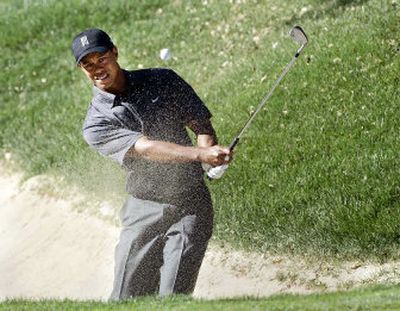Minor shots can also win majors

The best shots by major champions are not always the most memorable.
Sometimes, they look so routine that they don’t even get the courtesy of a replay. In the case of Tiger Woods at the British Open, his best were never shown on TV.
There was nothing extraordinary about his five-shot victory, a calculated performance at the Old Course that kept a small cast of challengers from catching him. Even so, Woods knew that Sunday at St. Andrews would be special, starting with a series of shots not many people saw.
That’s because they were on the practice range.
“I hit the 100-yard sign four straight times,” Woods said in an interview last week. “That was the start of my warmup. I hit a couple of little wedges to loosen up, then hit to the sign. Peppered it four straight times in the air, on the right zero – not the middle zero, the right zero.”
Swing coach Hank Haney was standing behind him, quietly impressed, and offered some advice to the caddie.
“He hit that sign four times in a row – and five out of eight,” Steve Williams said. “Hank says to me, ‘The first time he gets inside 100 yards, you might want to tell him to aim away from the flag.’ “
Turns out it wasn’t a joke.
“First time I’m inside 100 yards is on No. 6,” Woods said. “I had 98 yards to the hole. What happens? I one-hop it off the flag and it spins off the shelf.”
Woods scrambled for par, and on the way to the next tee, Williams told him what Haney said on the range.
“I said, ‘You idiot, why didn’t you just tell me to aim away from the flag?’ It’s not that hard,” Woods said.
The next time he had less than 100 yards was on No. 7.
Woods nearly holed out.
The other three majors had a defining shot, along with one that often gets overlooked:
Masters
Woods’ chip from behind the 16th green made a U-turn at the top of the slope, trickled toward the hole, paused 2 seconds on the edge of the cup for effect, and became part of Augusta National lore the moment it dropped for birdie.
As dramatic as that was, Woods was prouder of two shots that were simply steady – his 3-wood off the tee in the playoff with Chris DiMarco, and an equally pure 8-iron into 15 feet that set up his winning birdie.
“My two best golf shots of the week,” Woods said. “You can think of 16 all you want, but if 18 doesn’t happen, then it’s DiMarco’s – what a great chip and a great putt he made on 18, and all those things.”
U.S. Open
Michael Campbell was scratching out pars along the back nine as Tiger Woods was closing in. Woods certainly helped the cause with two late bogeys that gave Campbell a cushion.
But this was Pinehurst No. 2, where shots are dropped easily. Campbell delivered a knockout punch with his 20-foot birdie putt on the 17th hole that gave him a three-shot lead.
Still, the Kiwi won the U.S. Open on the par-3 15th with a bunker shot that ranks among the best of the year.
He missed the green to the left, and the only thing worse than a nasty lie was the length of the shot. He had to carry it some 25 yards to a turtleback green that fell off on all sides.
“It was semi-plugged, and I had to get it up over a little lip,” Campbell said. “If it goes 3 feet beyond the pin, it was off the green. Six feet below the pin, and it was off the green. That was the shot of the round.”
It came off perfectly, and he holed the 6-foot par putt.
PGA Championship
Phil Mickelson was up to his ankles in rough to the right of the 18th green, tied with Steve Elkington and Thomas Bjorn, needing to get up-and-down from some 50 feet to win his second major.
“It could have been the easiest chip, and still wouldn’t have been easy,” Mickelson said. “It was the situation that made it tough. The ball was sitting down a little bit in the grass, and I was able to go in and be aggressive with it because I had a little bit of upslope to the pin, and I didn’t fear the ball would take off by the hole.”
He raised his arms before the ball settled 2 feet away for a tap-in birdie.
While Mickelson is among the best with a wedge, the shot that might have won the PGA was his drive. Baltusrol was softer and longer, with a stiff breeze. Mickelson needed birdie to win. He needed to be in the fairway.
Mickelson reached out and tapped the plaque for Jack Nicklaus, who hit the 18th green with a 1-iron to win the 1967 U.S. Open. He could not have done that from the rough.